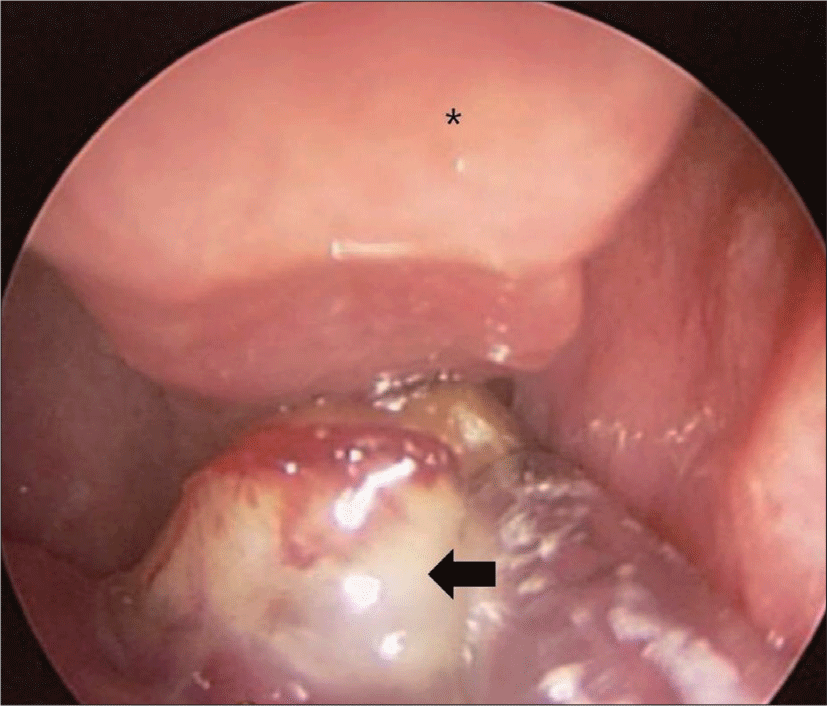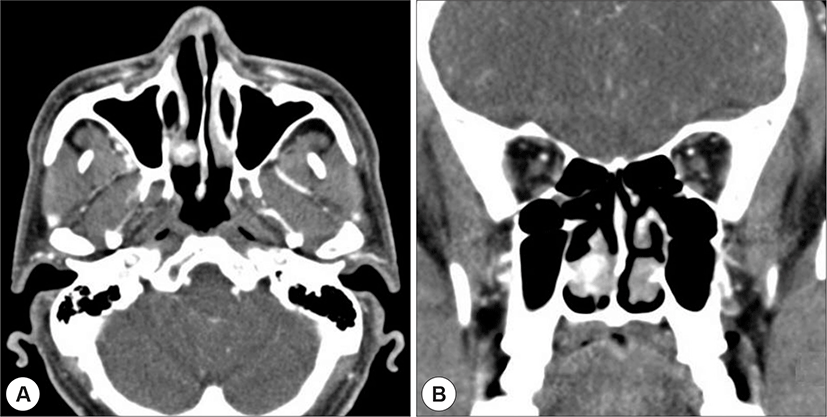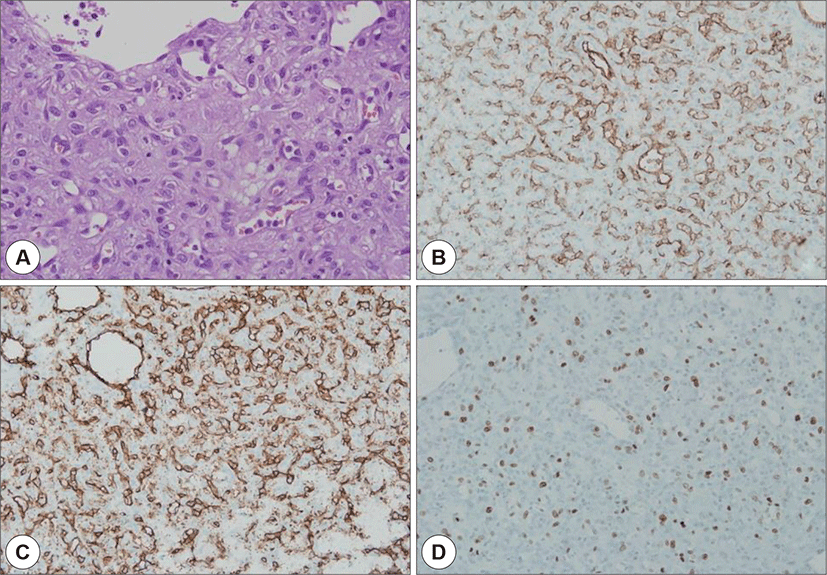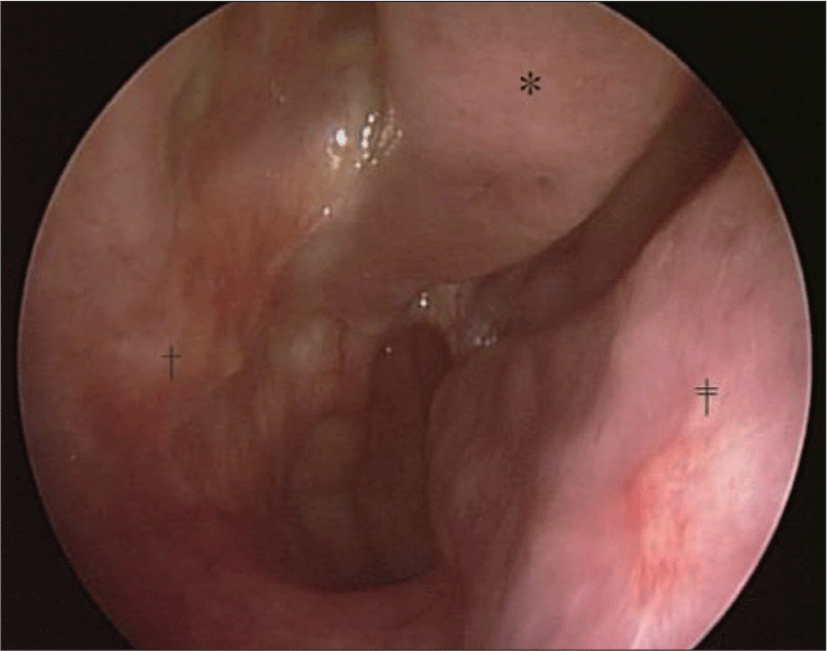서 론
상피모양 혈관내피종(Epithelioid hemangioendothelioma)은 상피세포처럼 보이는 내피세포의 증식이 특징적인 드문 혈관성 종양이며 Weiss 등이 1982년 처 음 명명하였다.1) 호발 부위는 피부 연조직, 간, 유방, 폐, 그리고 뼈로 알려져 있으며 두경부에서 생기는 경우는 드물다.1-3) 이 중 비강 내부에 발생하는 경우는 극히 드 물다고 알려져 있으며, 국내에는 최근까지 2예만이 보고 되었다. 최근 저자들은 54세 남성의 우측 비강에 발생한 상피모양 혈관내피종을 경험하였기에 문헌 고찰과 함께 보고하는 바이다.
증 례
54세 남자 환자가 우측의 반복적 비출혈과 코막힘을 주소로 내원하였다. 상기 증세 외에 발열, 통증 등 다른 호 소 증세는 없었다. 신체검진 시 비인두내시경 상 우측 하 비갑개 후부 내측에 지름 약 1.5 cm 가량의 종괴가 관찰 되었다(Fig. 1). 종괴의 표면은 불규칙했고 단단하였으 며 표면에 혈관이 발달되어 있었다. 종괴의 크기 및 침 범 정도를 평가하기 위해 조영증강 부비동 전산화 단층 촬영을 시행하였다. 우측 하비갑개 후부에 부착된 조영 증강이 잘 되는 15×11×12 mm 가량의 종괴가 확인되 었고, 그 외 양측 비강 내에 다른 병변은 관찰되지 않아 환자의 증세는 이 종괴에 의한 것으로 생각되었다(Fig. 2). 종합하여 하비갑개 점막에서 기원한 유경성의 혈관공급 이 풍부한 종물을 의심하였고, 치료 및 조직학적 진단을 위해 외과적 절제를 계획, 전신마취 하 단극성 전기소작 기로 종괴의 변연부를 따라 절제술을 시행하였다. 수술 전 전산화 단층촬영 상 종괴가 하비갑개에 국한되었으 며, 변연이 비교적 깨끗하고 잘 분리되어 보여 악성종양 으로 의심하지 않았고 동결절편검사를 시행치 않았다. 수술 후 급성 합병증은 없었다. 병리조직검사 상 H&E 염색 관찰 시 10/10 HPF 가량으로 높은 유사분열지수를 보였으며 면역학적 염색에서는 CD34, CD31, Factor 8, Ki-67에서 부분 양성을 보였고, cyclin D1, SMA(smooth muscle actin)에서는 음성 소견을 보여(Fig. 3) 상피모양 혈관내피종으로 진단되었다. 이후 조직검사 상 외과적 절제연이 충분하지 않아 확실한 절제면 확보를 위하여, 우측 하비갑개의 후방 1/3 가량을 추가 절제하였고, 재 조직검사에서 잔여 종양은 없는 것으로 확정되었다. 종 양의 전이 여부를 판단하기 위해 양전자 전산 단층촬영 을 시행하였고, 원격전이는 없었다. 환자는 수술 후 2일 뒤 퇴원하였고 이후 10개월이 지난 현재까지 재발 혹은 지연성 합병증 없이 외래 추적관찰 중이다(Fig. 4).




고 찰
상피모양 혈관내피종은 드문 혈관성 악성종양으로서 혈관내피세포나 그 전구세포에서 기원한다. 1975년 Dali 등이 폐의 세기관지 세포암종으로 처음 기술하였으며, 혈관종(hemangioma)과 혈관육종(hemangiosarcoma) 의 중간형태를 보인다고 하여 1982년 Weiss 등에 의해 상피모양 혈관내피종(epithelioid hemangioendothelioma)으로 명명되었다.1,4) 유병율이 1/1,000,000으로 매 우 드문 종양이며, 30대 중반의 성인에게서 호발하며 남 녀의 발생비는 1 : 4로 알려져 있다.4) 호발 부위는 간(21%), 간과 폐부의 동시 발생(18%), 골(14%), 폐부(12%) 순이 며 그 외 피하 연부조직, 후복막강, 림프절, 난소, 전립선, 눈꺼풀, 흉막 등 다양한 장기에서 발생할 수 있다.4) 전신 증세가 나타나거나 원격전이가 있는 경우나 조직학적으 로 높은 유사분열률을 보일 경우는 예후가 나쁘다.5) 상 피모양 혈관내피종 환자 39예에 대한 분석연구에서 환 자들의 5년 생존율은 81%였으며 3/50HPF 보다 높은 체 세포 분열률을 보인 환자군에서는 5년 생존율이 59%로 낮게 나타났다.6)
상피모양 혈관내피종은 독특한 조직학적, 면역조직화 학적 구조를 가지며 이를 통해 진단할 수 있다. 조직학 상 뭉치와 줄(nests and cords) 모양으로 배열된 둥근 세포 핵을 가지며 세포질 내 액포(intra-cytoplasmic vacuole) 가 두드러진 내피세포, 주위에서 방추형의 종양 세포도 관찰할 수 있다.2,4) 면역조직화학적으로는 Fli-1 factor, CD31, CD34 등을 참조 표지자로 활용할 수 있다.4,7) 외 과적 절제를 시행함이 원칙이나, 환자에 따라 자연관해 되는 경우도 있어 무증상이며 광범위한 병변일 경우 치 료없이 추적관찰 해볼 수 있다.8)
기존에 보고된 증례들의 분석 시 주 증상으로 코피를 호소하는 경우가 가장 많았고, 비강 내 종양이 발생한 위 치는 중비갑개, 비중격, 비강 측벽, 후비공, 뇌 두개저로 다양하였다. 수술 시 가장 많이 쓰인 술식은 내시경하 광 범위 절제술이었으며, Girolamo 등은 얼굴중간노출술 식(Midfacial degloving)으로 수술하기도 했고, 두개저 를 침범한 환자에서 Ogita 등은 두개안면 절제술 (Craniofacial resection)을 이용하여 제거하였다.9,10) 9개월 이상의 추적관찰 기록이 있는 9건의 증례 중 재발은 1예 있었으며, 이 환자는 4세의 남아로 첫 절제 시 완전절제 를 하지 못하고 부분절제술을 시행한 것이 원인으로 추 정됐다(Table 1).11)
| Author | Age/sex | Chief complaint | Location | Surgery | Recurrence |
|---|---|---|---|---|---|
| Di Girolamo A, et al.9) | 23/M | Epistaxis | Right middle turbinate | Midfacial degloving approach | No |
| Ogita S, et al.10) | 27/F | Epistaxis | Left nasal cavity with skull base invasion | Craniofacial resection | No |
| Naqvi J, et al.11) | 4/M | Nasal obstruction | Nasal cavity | Wide excision | 2 times |
| Patnayak R, et al.3) | 40/M | Epistaxis | Right nasal septum | ESS | No |
| Hanege FM, et al.12) | 62/M | Epistaxis Nasal obstruction | Left nasal septum | ESS | No |
| Kim EH, et al.13) | 17/M | Epistaxis | Left middle turbinate | ESS | No |
| Navalón-Ramon E, et al.14) | 32/F | Epistaxis Rhinorrhea | Left middle turbinate | ESS | No |
| Sohn JH, et al.15) | 22/M | Epistaxis Nasal obstruction | Choana | ESS | No |
| Tseng CC, et al.16) | 25/M | Epistaxis | Right uncinate process | ESS | No |
흔한 경우는 아니나, 비강 내에 발생하는 경우 병변 위 치에 따라 시야확보 및 기구 접근이 용이하며, 비교적 간 단한 장비로 수술이 가능하고 우려되는 주요 합병증이 없기 때문에 근치적 외과적 절제를 우선 고려할 수 있다. 본 증례에서도 0° 직선형 내시경만으로도 시야 확보 및 기구 접근이 원활하여 완전 절제에 큰 어려움이 없었다. 또한 수술 전 비인두내시경 상 종괴 표면에 혈관발달이 풍부함을 확인했고 대량 출혈을 우려해 전신마취 하에 절제술을 시행하였으나, 수술 도중 및 후에 대량 출혈을 포함한 합병증은 발생하지 않았으며, 수술 후 10개월간 의 추적관찰에도 재발 등 이상소견은 보이지 않았다. 따 라서 종괴가 크지 않고, 접근이 쉬운 위치에 발생했다면 국소 마취 하에도 외과적 절제가 가능할 것으로 생각된 다. 다만 상피모양 혈관내피종은 악성종양에 준해 수술 시 절제연을 확보해야 하나, 흔한 종양이 아니라 의심하 기 어려워 충분히 절제하지 못하는 경우가 생길 수 있다. 혈관종이 의심되거나 혈관발달이 풍부한 비강 내 종괴 를 절제하게 될 경우, 집도의는 비강의 생리적 기능에 영 향주지 않는 선에서 충분한 절제연을 포함해 절제한다 면 재수술을 피할 수 있을 것이다. 또한 안와판, 사상판 등 비강 내의 위험구조물 주위에 종괴가 생겼다면 합병 증 발생을 염두에 두고 고난도 내시경 하 부비동 수술에 준하여 조심히 제거해야 할 것이다.
